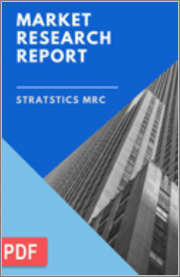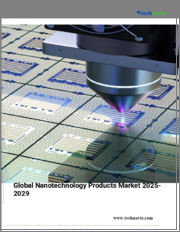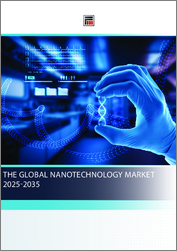
|
시장보고서
상품코드
1358969
세계의 나노바이오테크놀러지 시장 예측(-2030년) : 유형별, 치료법별, 기술별, 용도별 및 지역별 분석Nanobiotechnology Market Forecasts to 2030 - Global Analysis By Type (10-100 Nm and 0-10 Nm), Therapeutic (Orthopedic Therapies, Dental Therapies, Cardiac Therapies, Liposomes and Other Therapeutics), Technology, Application and By Geography |
||||||
Stratistics MRC에 따르면, 세계 나노바이오테크놀러지 시장은 2023년 1,126억 6,600만 달러로 예측 기간 동안 CAGR 7.5%로 성장하여 2030년 1,869억 1,000만 달러에 달할 것으로 예상됩니다.
분자 및 미세 입자를 포함하는 나노 스케일 수준의 생물학적 시스템에 대한 연구는 종종 나노바이오테크놀러지으로 알려져 있으며, 나노 기술과 생명공학 분야의 융합입니다. 나노바이오기술과 동시에 사용되는 다른 용어로는 나노생물학 및 바이오나노기술이 있으며, 100나노미터보다 작은 규모의 물질 조작을 통해 재료, 장치 및 시스템을 제조하고 사용하는 것을 총칭하여 "나노바이오기술 응용"이라고 합니다. 전 세계적으로 정부와 기업은 나노바이오테크놀러지에 많은 투자를 하고 있습니다.
식량농업기구에 따르면 2050년까지 세계 인구는 97억 명을 넘어설 것으로 예상됩니다.
만성질환의 증가
나노바이오 시장의 중요한 성장 촉진요인은 전 세계적으로 암, 당뇨병, 심혈관 질환과 같은 만성 질환의 유병률이 증가하고 있다는 점입니다. 특정 질병에 대한 기존 치료법의 문제점에 대한 더 나은 해결책은 나노바이오테크놀러지에 의해 제공됩니다. 예를 들어, 나노입자 기반 약물전달 시스템을 통해 집중 치료가 가능해져 부작용을 줄이고 환자 결과를 개선할 수 있습니다. 전 세계적으로 만성 질환의 부담이 증가함에 따라 창의적인 나노바이오기술 솔루션의 필요성이 증가하고 있습니다.
높은 개발비용
나노바이오기술 제품이 개발되고 상용화되기 위해서는 인프라, 전문 장비, 인력, 연구개발 활동에 많은 투자가 필요합니다. 그러나 나노바이오기술의 높은 개발비용은 특히 자금력이 부족한 스타트업과 중소기업(SME)의 경우, 개발의 걸림돌이 될 수 있습니다. 이 장벽을 극복하기 위해서는 자본과 투자 가능성에 대한 접근이 필수적입니다.
나노바이오테크놀러지에 대한 투자 증가
임상시험 중인 신규성, 독창성 및 잠재력이 있는 제품의 양이 증가함에 따라 세계 나노 바이오 기술 시장의 발전이 가속화될 것으로 보입니다. 전 세계 기업과 정부는 나노바이오테크놀러지에 많은 투자를 하고 있습니다. 또한 많은 정부 기관이 나노바이오테크놀러지 연구 및 발전에 대한 투자 금액을 늘리고 있습니다. 기업들은 새로운 제품을 시장에 출시하기 위해 연구개발에 적극적으로 투자하고 있습니다. 나노바이오테크놀러지 분야에서 이러한 혁신적 도구는 기업들에게 경쟁 우위를 가져다주고 있습니다.
독성과 장기적 영향
나노바이오테크놀러지은 특수한 특성과 잠재적 위험성을 가진 나노 크기의 물질을 이용합니다. 이 때문에 규제 기관은 나노바이오 제품을 인증하고 판매할 때 우려를 표명하고 있습니다. 나노 물질의 독성 및 인체 건강과 환경에 미치는 장기적인 영향에 대한 안전성에 대한 우려로 인해 감시와 감독을 강화할 것으로 예상됩니다. 따라서 예측 기간 동안 이러한 요인들은 나노바이오테크놀러지 시장의 성장을 저해할 것으로 예상됩니다.
COVID-19의 영향:
COVID-19 사태는 효율적인 약물과 백신 개발뿐만 아니라 신속하고 정확한 진단의 중요성을 강조하고 있습니다. 진단 검사의 민감도와 특이성을 높이고 약물전달 시스템을 강화할 수 있는 능력을 가진 나노바이오테크놀러지은 이 두 분야에서 중요한 의미를 갖는다. 헬스케어 솔루션에 대한 관심은 나노바이오테크놀러지 산업의 확장을 가속화할 수 있습니다. 정부 및 민간 투자자들이 COVID-19 관련 분야의 연구개발에 자금과 자원을 투입했을 가능성이 있습니다. 바이러스 관련 주제에 집중하는 나노바이오테크놀러지 기업에 더 많은 자금이 제공되었을 수 있습니다.
예측 기간 동안 제약 분야가 가장 큰 비중을 차지할 것으로 예상
예측 기간 동안 제약 분야가 가장 큰 점유율을 차지할 것으로 예상됩니다. 의약품 제조 및 유통에는 나노 규모의 재료, 장치 및 절차가 사용됩니다. 또한, 이 분야는 의약품의 개발, 전달 및 치료 효과를 변화시킬 수 있는 잠재력을 가지고 있으며, 다양한 질병에 대한 보다 개인화되고 집중적인 치료를 가능하게 합니다.
예측 기간 동안 가장 높은 CAGR을 보일 것으로 예상되는 분야는 정형외과 치료 분야
정형외과용으로 특별히 설계된 나노 소재, 약물전달 시스템 및 진단 장비의 개발이 크게 발전함에 따라 정형외과 치료 분야는 예측 기간 동안 수익성 있는 성장을 이룰 것으로 예상됩니다. 또한, 나노바이오기술은 나노입자 및 나노복합체와 같은 나노물질을 사용하여 손상된 조직에 표적화된 약물전달을 가능하게 하여 치료의 생체 이용률을 높이고 조직 재생을 지원할 수 있습니다. 정형외과 질환의 조기 발견과 모니터링도 나노 스케일 영상 진단 방법으로 개선되고 있습니다.
가장 큰 점유율을 차지하는 지역
북미 지역이 예측 기간 동안 가장 큰 점유율을 차지할 것으로 예상됩니다. 안정된 규제 환경은 이 지역의 나노 바이오 기술 개발에 유리한 분위기를 조성하고 있습니다. 미국 FDA 및 기타 규제 기관은 나노 기술 제품의 효능과 안전성을 보장하기 위해 기업 및 연구자들과 긴밀히 협력했습니다. 또한 산업계의 협력과 정부의 강력한 지원은 이 지역 시장의 성공에 중요한 요소로 작용하고 있습니다.
CAGR이 가장 높은 지역:
유럽은 성공적인 임상시험과 최종 식품의약국(FDA) 인증으로 인한 제약 및 생명공학 산업의 양호한 성장 전망으로 인해 가장 높은 성장세를 보일 것으로 예상됩니다. 기술적으로 진보된 제품에 대한 수요 증가와 R&D 시설의 확충이 지역 시장 확대를 이끄는 주요 요인으로 꼽힙니다. 지역 시장 확대에 기여할 것으로 예상되는 다른 측면으로는 생명공학 부문의 확대, 정부의 투자 및 노력, 암 연구 및 표적 의약품, 농업 및 환경 응용, 전자기기 및 재료의 나노기술 등이 있습니다.
무료 맞춤형 서비스
이 보고서를 구독하는 고객은 다음과 같은 무료 맞춤형 옵션 중 하나를 사용할 수 있습니다:
- 회사 프로필
- 추가 시장 기업의 종합적인 프로파일링(최대 3개사까지)
- 주요 기업 SWOT 분석(3개사까지)
- 지역 세분화
- 고객의 관심에 따른 주요 국가별 시장 추정 및 예측, CAGR(참고: 타당성 검토에 따른)
- 경쟁사 벤치마킹
- 제품 포트폴리오, 지리적 입지, 전략적 제휴를 기반으로 한 주요 기업 벤치마킹
목차
제1장 주요 요약
제2장 서문
- 개요
- 이해관계자
- 조사 범위
- 조사 방법
- 데이터 마이닝
- 데이터 분석
- 데이터 검증
- 조사 접근법
- 조사 소스
- 1차 조사 소스
- 2차 조사 소스
- 가정
제3장 시장 동향 분석
- 성장 촉진요인
- 성장 억제요인
- 기회
- 위협
- 기술 분석
- 용도 분석
- 신흥 시장
- 신종 코로나바이러스 감염증(COVID-19)의 영향
제4장 Porter's Five Forces 분석
- 공급 기업의 교섭력
- 구매자의 교섭력
- 대체품의 위협
- 신규 참여업체의 위협
- 경쟁 기업 간의 경쟁 관계
제5장 세계의 나노바이오테크놀러지 시장 : 유형별
- 10-100Nm
- 0-10Nm
제6장 세계의 나노바이오테크놀러지 시장 : 치료법별
- 정형외과 요법
- 치과 치료
- 심장 치료
- 리포솜
- 기타 치료법
제7장 세계의 나노바이오테크놀러지 시장 : 기술별
- 나노입자
- 나노쉘
- 나노튜브
- 기타 기술
제8장 세계의 나노바이오테크놀러지 시장 : 용도별
- 유전체학
- 약물전달
- 단백질체학
- 의약품
- 식료와 농업
- 의료기기
- 의학 조사
- 기타 용도
제9장 세계의 나노바이오테크놀러지 시장 : 지역별
- 북미
- 미국
- 캐나다
- 멕시코
- 유럽
- 독일
- 영국
- 이탈리아
- 프랑스
- 스페인
- 기타 유럽
- 아시아태평양
- 일본
- 중국
- 인도
- 호주
- 뉴질랜드
- 한국
- 기타 아시아태평양
- 남미
- 아르헨티나
- 브라질
- 칠레
- 기타 남미
- 중동 및 아프리카
- 사우디아라비아
- 아랍에미리트
- 카타르
- 남아프리카공화국
- 기타 중동 및 아프리카
제10장 주요 발전
- 계약, 파트너십, 협업, 합작투자
- 인수와 합병
- 신제품 발매
- 사업 확대
- 기타 주요 전략
제11장 기업 개요
- Abbott Laboratories
- Advanced Nano Products Co., Ltd
- Altair Nanotechnologies Inc
- Biosensors International Group, Ltd
- Bruker Corporation
- Calando Pharmaceuticals
- Celgene Corporation
- Dendritic Nanotechnologies
- Elan Pharmaceuticals
- eSpin Technologies, Inc
- Flamel Technologies
- Imina Technologies SA
- Johnson & Johnson
- Nano Bridging Molecules SA
- Novartis AG
- Thermo Fisher Scientific Inc
- XanTecbioanalytics GmbH
According to Stratistics MRC, the Global Nanobiotechnology Market is accounted for $112.66 billion in 2023 and is expected to reach $186.91 billion by 2030 growing at a CAGR of 7.5% during the forecast period. The study of biological systems at the nanoscale level, often including molecules and microscopic particles, is known as nanobiotechnology and is a blend of the nanotechnology and biotechnology fields. Other terms that are used simultaneously with nanobiotechnology include nanobiology and bionanotechnology. The production and usage of materials, devices, and systems through the manipulation of matter at scales smaller than 100 nanometers are collectively referred to as "nanobiotechnology applications. Globally, governments and businesses are investing heavily in nanobiotechnology.
According to Food & Agriculture Organization, the world population is anticipated to surpass 9.7 billion by 2050.
Market Dynamics:
Driver:
Increased incidence of chronic diseases
A significant growth driver for the nanobiotechnology market is the rising prevalence of chronic diseases, including cancer, diabetes, and cardiovascular problems, around the world. Better solutions to problems with conventional therapies for certain illnesses are provided by nanobiotechnology. For instance, focused therapy is made possible by nanoparticle-based drug delivery systems, which also reduce side effects and enhance patient outcomes. The need for creative nanobiotechnology solutions is growing as the burden of chronic diseases increases globally.
Restraint:
High development expenses
Nanobiotechnology products require large investments in infrastructure, specialized equipment, staff, and research and development activities in order to be developed and commercialized. However, nanobiotechnology's high development costs might be a deterrent, especially for startups or small and medium-sized businesses (SMEs) with restricted funding sources. To break through this barrier, access to capital and investment possibilities is essential.
Opportunity:
Increasing investments in nanobiotechnology
A rise in the quantity of novel, inventive, and promising products undergoing clinical trials will accelerate the development of the global nanobiotechnology market. Businesses and governments around the world are making significant investments in nanobiotechnology. Additionally, many government organizations have increased the amount of money that is invested in the study and advancement of nanobiotechnology. To bring novel products to market, businesses are actively investing in research and development. In the nanobiotechnology sector, these innovative tools give businesses a competitive advantage.
Threat:
Toxicity and long term impacts
Nanobiotechnology makes use of materials at the nanoscale, which have special qualities and potential hazards. Because of this, regulatory bodies have been concerned while certifying and releasing nanobiotechnology products for sale. It is anticipated that increased scrutiny and oversight will be required due to safety concerns over the toxicity and long-term impacts of nanomaterials on human health and the environment. Thus, during the course of the forecast period, these factors are anticipated to hinder the expansion of the nanobiotechnology market.
COVID-19 Impact:
The COVID-19 epidemic has highlighted the significance of quick and precise diagnosis as well as the creation of efficient medications and vaccinations. With the ability to increase the sensitivity and specificity of diagnostic tests and enhance drug delivery systems, nanobiotechnology is significant in both fields. The focus on healthcare solutions may have accelerated the expansion of the nanobiotechnology industry. Funds and resources may have been transferred by governments and private investors to research and development in COVID-19-related fields. There may have been more funding available for nanobiotechnology companies focusing on virus-related topics.
The pharmaceuticals segment is expected to be the largest during the forecast period
Pharmaceuticals segment is expected to hold largest share over the projection period. In the manufacturing and distribution of pharmaceutical products, nanoscale materials, devices, and procedures are used. Additionally, this area has the potential to transform medication development, delivery, and therapeutic efficacy, enabling more individualized and focused treatments for a range of illnesses.
The orthopedic therapies segment is expected to have the highest CAGR during the forecast period
Due to significant advances in the creation of nanomaterials, drug delivery systems, and diagnostic instruments specifically designed for orthopedic purposes, the orthopedic therapies segment is anticipated to experience profitable growth over the course of the projected period. Additionally, through the use of nanomaterials like nanoparticles and nanocomposites, nanobiotechnology enables targeted drug delivery to injured tissues, improves the bioavailability of treatments, and supports tissue regeneration. The early detection and monitoring of orthopedic disorders are also being improved by nanoscale imaging and diagnostic methods.
Region with largest share:
North America is expected to hold largest share over the projection period. A stable regulatory environment created a favorable atmosphere for the development of nanobiotechnology in the region. The FDA and other regulatory bodies in the US collaborated closely with businesses and researchers to guarantee the efficacy and safety of nanotech products. Additionally, industry collaboration and robust government support are key factors in the regional market's success.
Region with highest CAGR:
Due to favorable growth prospects for the pharmaceutical and biotechnology industries brought on by successful clinical trials and eventual Food and Drug Administration (FDA) certification, Europe is expected to have the highest growth. The main drivers of regional market expansion are the increasing demand for technologically advanced products and well-developed R&D facilities. Other aspects that are anticipated to contribute to regional market expansion include the expanding biotechnology sector, government investments and efforts, cancer research and targeted medicines, agriculture and environmental applications, and nanotechnology in electronics and materials.
Key players in the market:
Some of the key players in Nanobiotechnology market include: Abbott Laboratories, Advanced Nano Products Co., Ltd, Altair Nanotechnologies Inc, Biosensors International Group, Ltd, Bruker Corporation, Calando Pharmaceuticals, Celgene Corporation, Dendritic Nanotechnologies, Elan Pharmaceuticals, eSpin Technologies, Inc, Flamel Technologies, Imina Technologies SA, Johnson & Johnson, Nano Bridging Molecules SA, Novartis AG, Thermo Fisher Scientific Inc and XanTecbioanalytics GmbH.
Key Developments:
In September 2023, Abbott has entered a definitive agreement for the acquisition of Bigfoot Biomedical, which develops smart insulin management systems for individuals with diabetes.
Types Covered:
- 10-100 Nm
- 0-10 Nm
Therapeutics Covered:
- Orthopedic Therapies
- Dental Therapies
- Cardiac Therapies
- Liposomes
- Other Therapeutics
Technologies Covered:
- Nanoparticles
- Nanoshells
- Nanotubes
- Other Technologies
Applications Covered:
- Genomics
- Drug Delivery
- Proteomics
- Pharmaceuticals
- Food and Agriculture
- Medical Devices
- Medical Research
- Other Applications
Regions Covered:
- North America
- US
- Canada
- Mexico
- Europe
- Germany
- UK
- Italy
- France
- Spain
- Rest of Europe
- Asia Pacific
- Japan
- China
- India
- Australia
- New Zealand
- South Korea
- Rest of Asia Pacific
- South America
- Argentina
- Brazil
- Chile
- Rest of South America
- Middle East & Africa
- Saudi Arabia
- UAE
- Qatar
- South Africa
- Rest of Middle East & Africa
What our report offers:
- Market share assessments for the regional and country-level segments
- Strategic recommendations for the new entrants
- Covers Market data for the years 2021, 2022, 2023, 2026, and 2030
- Market Trends (Drivers, Constraints, Opportunities, Threats, Challenges, Investment Opportunities, and recommendations)
- Strategic recommendations in key business segments based on the market estimations
- Competitive landscaping mapping the key common trends
- Company profiling with detailed strategies, financials, and recent developments
- Supply chain trends mapping the latest technological advancements
Free Customization Offerings:
All the customers of this report will be entitled to receive one of the following free customization options:
- Company Profiling
- Comprehensive profiling of additional market players (up to 3)
- SWOT Analysis of key players (up to 3)
- Regional Segmentation
- Market estimations, Forecasts and CAGR of any prominent country as per the client's interest (Note: Depends on feasibility check)
- Competitive Benchmarking
- Benchmarking of key players based on product portfolio, geographical presence, and strategic alliances
Table of Contents
1 Executive Summary
2 Preface
- 2.1 Abstract
- 2.2 Stake Holders
- 2.3 Research Scope
- 2.4 Research Methodology
- 2.4.1 Data Mining
- 2.4.2 Data Analysis
- 2.4.3 Data Validation
- 2.4.4 Research Approach
- 2.5 Research Sources
- 2.5.1 Primary Research Sources
- 2.5.2 Secondary Research Sources
- 2.5.3 Assumptions
3 Market Trend Analysis
- 3.1 Introduction
- 3.2 Drivers
- 3.3 Restraints
- 3.4 Opportunities
- 3.5 Threats
- 3.6 Technology Analysis
- 3.7 Application Analysis
- 3.8 Emerging Markets
- 3.9 Impact of Covid-19
4 Porters Five Force Analysis
- 4.1 Bargaining power of suppliers
- 4.2 Bargaining power of buyers
- 4.3 Threat of substitutes
- 4.4 Threat of new entrants
- 4.5 Competitive rivalry
5 Global Nanobiotechnology Market, By Type
- 5.1 Introduction
- 5.2 10-100 Nm
- 5.3 0-10 Nm
6 Global Nanobiotechnology Market, By Therapeutic
- 6.1 Introduction
- 6.2 Orthopedic Therapies
- 6.3 Dental Therapies
- 6.4 Cardiac Therapies
- 6.5 Liposomes
- 6.6 Other Therapeutics
7 Global Nanobiotechnology Market, By Technology
- 7.1 Introduction
- 7.2 Nanoparticles
- 7.3 Nanoshells
- 7.4 Nanotubes
- 7.5 Other Technologies
8 Global Nanobiotechnology Market, By Application
- 8.1 Introduction
- 8.2 Genomics
- 8.3 Drug Delivery
- 8.4 Proteomics
- 8.5 Pharmaceuticals
- 8.6 Food and Agriculture
- 8.7 Medical Devices
- 8.8 Medical Research
- 8.9 Other Applications
9 Global Nanobiotechnology Market, By Geography
- 9.1 Introduction
- 9.2 North America
- 9.2.1 US
- 9.2.2 Canada
- 9.2.3 Mexico
- 9.3 Europe
- 9.3.1 Germany
- 9.3.2 UK
- 9.3.3 Italy
- 9.3.4 France
- 9.3.5 Spain
- 9.3.6 Rest of Europe
- 9.4 Asia Pacific
- 9.4.1 Japan
- 9.4.2 China
- 9.4.3 India
- 9.4.4 Australia
- 9.4.5 New Zealand
- 9.4.6 South Korea
- 9.4.7 Rest of Asia Pacific
- 9.5 South America
- 9.5.1 Argentina
- 9.5.2 Brazil
- 9.5.3 Chile
- 9.5.4 Rest of South America
- 9.6 Middle East & Africa
- 9.6.1 Saudi Arabia
- 9.6.2 UAE
- 9.6.3 Qatar
- 9.6.4 South Africa
- 9.6.5 Rest of Middle East & Africa
10 Key Developments
- 10.1 Agreements, Partnerships, Collaborations and Joint Ventures
- 10.2 Acquisitions & Mergers
- 10.3 New Product Launch
- 10.4 Expansions
- 10.5 Other Key Strategies
11 Company Profiling
- 11.1 Abbott Laboratories
- 11.2 Advanced Nano Products Co., Ltd
- 11.3 Altair Nanotechnologies Inc
- 11.4 Biosensors International Group, Ltd
- 11.5 Bruker Corporation
- 11.6 Calando Pharmaceuticals
- 11.7 Celgene Corporation
- 11.8 Dendritic Nanotechnologies
- 11.9 Elan Pharmaceuticals
- 11.10 eSpin Technologies, Inc
- 11.11 Flamel Technologies
- 11.12 Imina Technologies SA
- 11.13 Johnson & Johnson
- 11.14 Nano Bridging Molecules SA
- 11.15 Novartis AG
- 11.16 Thermo Fisher Scientific Inc
- 11.17 XanTecbioanalytics GmbH



















